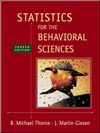 |  Statistics for the Behavioral Sciences, 4/e Michael Thorne,
Mississippi State University -- Mississippi State
Martin Giesen,
Mississippi State University -- Mississippi State
Definitions and Scaling
Chapter Overview| A variable is anything that may take on different values or amounts. In research, two variables of interest are the independent variable and the dependent variable. The independent variable is the one manipulated or controlled by the researcher. The dependent variable in behavioral science is the measurement of behavior.Population refers to a complete collection of objects or organisms having some common characteristic. A subset of a population is called a sample. A measurable characteristic of a population is called a parameter, whereas a measurable characteristic of a sample is called a statistic.
The process of selecting a sample from a population is called sampling. If a sample accurately reflects its parent population, it is an unbiased sample; an unrepresentative sample is called biased. In random sampling, each member of the population theoretically has a chance of being selected; random sampling is sometimes called random and independent sampling or just independent sampling because selecting one object or person for a sample has no effect (is independent of) the probability of selecting another object or person. Sampling with replacement means that each selected individual is returned to the population before the next selection; in sampling without replacement, the individual is not returned. In stratified random sampling, the population is divided into strata or groups, and random samples are taken from each strata.
Two basic types of data are measurement data and frequency data. Measurement data involve a true measurement process, whereas frequency data consist of counts, totals, or frequencies. Nominal scale data are generally frequency data, whereas ordinal, interval, and ratio scale data involve some form of measurement.Scales of measurement are the rules used for assigning numbers to objects or events. From least to most complex, the measurement scales are nominal, ordinal, interval, and ratio. The nominal scale gives names or labels to different objects or events. Numbers on football jerseys are a nominal scale. Ordinal scale numbers serve both to identify and to rank-order the objects or events. An example of an ordinal scale might be the numbers 1–6 used both to identify finishers in a 5K race and to indicate their order of finish. In addition to providing categorizing and ranking properties, the interval scale has equal intervals between the scores. An example is the Fahrenheit temperature scale. Rating scales can cautiously be assumed to be interval-level measurement. A ratio scale is an interval scale with a true zero. Examples include time and weight. It is important to be aware of scales of measurement because some statistical techniques require particular scales of measurement.Descriptive statistics are used to illustrate quantities of numerical observations. Examples include graphs and averages. Inferential statistical techniques permit us to make conclusions about a larger group based on some subset of it and tell us how confident we are in our conclusions.
|
|



 2003 McGraw-Hill Higher Education
2003 McGraw-Hill Higher Education